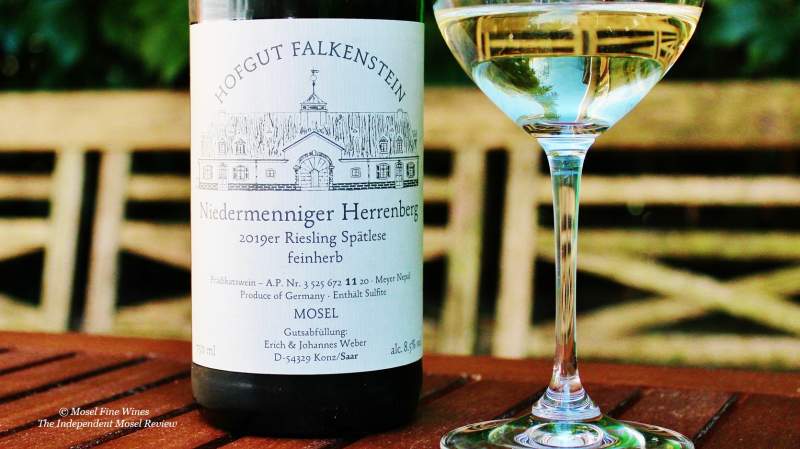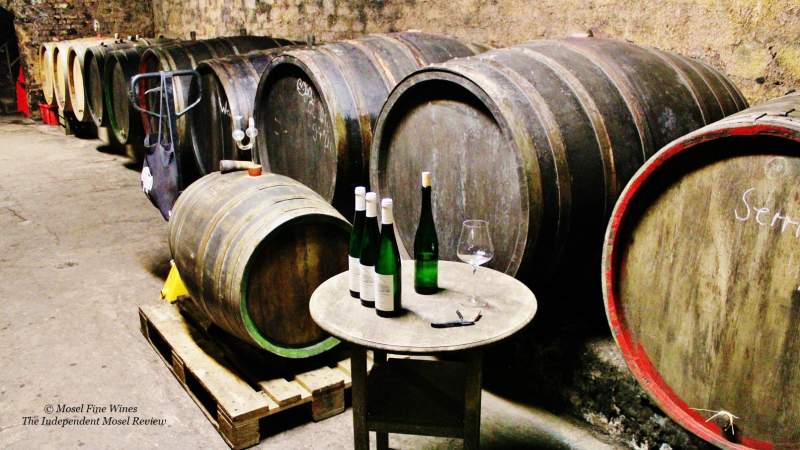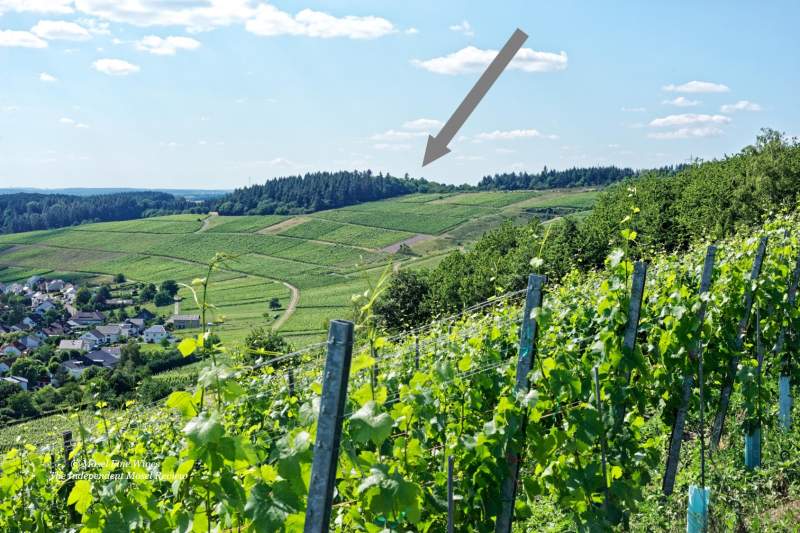July 6, 2020 | News | Issue Highlights

2019 is an epic vintage at the top as Hofgut Falkenstein underlines with this majestic off-dry beauty.


We already wrote this in our sneak preview to our readers in the January Issue. Our tastings published in Part I of our detailed vintage report amply confirmed it: 2019 is an epic vintage at the top, and this thanks to not excessive Oechsle degrees, bright and ripe flavors, and impeccable sweetness-acidity balance.
One of the absolute highlights of the vintage turns out to be the otherworldly Niedermenniger Herrenberg Riesling Spätlese Feinherb Meyer Nepal by Hofgut Falkenstein.
Hofgut Falkenstein is a beautiful Estate tucked away in a side valley behind the Saar called Konzer Tälchen (literally meaning "the little valley of Konz"). Erich Weber set up his Estate in the early 1980s and runs it now together with his son Johannes.
The Estate has been a fine source for steely expressions of Saar Riesling since the start. However, the level of finesse has soared over the last few years while the ethos of the Webers remained unchanged: “We want to produce light-weighted, playful, and complex wines. This expresses the beauty of our Saar vineyards so well.”
In order to retain this freshness, the Estate does not defoliate, aims at low yields so that the grapes are ripe early, and harvest early in order to get ripe grapes with not excessive sugar content. They also press whole-bunch and fraction the pressing to retain lightness and acidity. Winemaking is as traditional as can be: Wild yeasts, old Fuder casks, no additives or other interventions except for racking, and a little sulfur and filtering at bottling.

The resulting wines show stunning brightness and delicacy. They are intense yet gorgeously light-footed … and they embrace acidity. The wines need time ... as did most of the great Mosel wines from the 1980s and the 1990s. The Estate has been on fire since 2014 (we amply reported on it), and its wines have been fixed features in our list of yearly highlights for years now, and this in all stylistic directions, lately in 2018!
On paper, 2019 was far from easy: Frost hit the region in Spring, heat waves led to sunburnt grapes in the Summer, and rain affected the harvest. And yet, the resulting wines crafted by Hofgut Falkenstein are simply superb.
So what did happen? Johannes Weber provided some answers when we talking to him about his collection for our Estate review (see Mosel Fine Wines Issue No 52 – June 2020): “2019 was, again, an early vintage. In some past vintages, we felt that we had been ever so slightly too late to get the lightness we so aspire to in our wines. So we decided to start our harvest already on September 14. Picking this early was not an issue because our grapes were ripe despite low levels of sugar density. In the end, 2019 allowed us to make wines with great airiness and elegance. It is a vintage made for Falkenstein.”
One of the core vineyards (one might argue: "the home turf") of Hofgut Falkenstein is the Niedermenniger Herrenberg, a wide vineyard which ranges from below the Falkenstein Estate over half a mile into the side valley. Over the years, the Estate consolidated a whole series of parcels throughout the finer parts of this iron-rich but essentially grey slate and quartz-infused, south-facing gentle slope.
The Estate bottles each cask separately, as was the norm in the old days. In order to differentiate between its casks (and subsequently its bottlings), the Webers give each of them a nickname. This is usually the name or nickname of previous owners, and sometimes just that of the “Lieu-Dit”.
Meyer Nepal refers to parcels situated high up the hill (“already at the level of the wood crest”, as Johannes points out – see the arrow on the image here below), which the Webers took over from a local grower called Meyer. Where does the Nepal bit then came from? Johannes Weber laughed and said that it resulted from an internal joke: “We took over three parcels from Meyer which were all three of high quality. When we saw how high this parcel was up the hill, we thought to ourselves: This is as high as Nepal.” Marketing can be that simple!

The Meyer Nepal parcel yields an off-dry wine (usually a Spätlese) which carries the AP 11 (see our article on AP numbers, this handy tool to decipher the German wine label). As Johannes explained, in 2019 they harvested this parcel in the middle of their harvest (on September 25), at a low 84° Oechsle. Some growers would find this even low for Kabinett, not so the Webers: “While the technical analysis may make one think of Kabinett. But this wine has density and some Schmelz, which makes it a Spätlese for us.”
The resulting wine proved an absolute highlight of our Spring tastings. As we amply wrote, 2019 vintage is an epic vintage at the top and there are lots of wines which made us shiver of delight. This one is stood out, even in such illustrious company. The Niedermenniger Herrenberg Spätlese Feinherb AP 11 proves crystalline, delicately smooth yet bracingly lemony, animating, soothing, zesty and fruity. But above all, it is simply at ease with itself, as if achieving such excellence is the easiest thing in the world. This is a true hallmark of all great wines. For lovers of Saar raciness and slenderness, wine hardly gets better than this.
Now to the bad news: There is only one cask of this wine. Should this be already sold out in your market (we understand that our high rating made our readers plunge on this bottling), the Estate has dished its finest collection of off-dry wines to date and the other bottlings of Niedemenniger Herrenberg Spätlese Feinherb are also often modern-day classics in the making.
Happy hunting!
The stunning 2019 collection by Hofgut Falkenstein
was reviewed in the Mosel Fine Wines Issue No 52 (Jun 2020).
You are a subscriber and miss this Issue?
Simply send us a request by
email
and we will be happy to send you a copy.
You are not yet a subscriber and wish to get this Issue?
Subscribe free of charge by registering yourself here below and ask us for a copy by email.
2019er
Falkenstein
Niedermenniger Herrenberg Spätlese Feinherb Meyer Nepal
11 20
98
The 2019er Niedermennig Herrenberg Riesling Spätlese Feinherb Meyer Nepal (the reference to this internal cask name is provided in small print on the label) comes from the upper part of the vineyard, and was fermented down to off-dry levels of residual sugar (27 g/l). This bright-white-colored wine offers a stunning nose of white peach, freshly cut garden apple, wet stone, delicate herbal elements, and a hint of whipped cream. The wine is simply stunningly intense and engaging on the palate, where the very subtle peachy elements are lifted up by some staggering ripe zesty fruits and minerals, as well as a subtle touch of lemony whipped cream. The finish is vibrating, smooth, racy, and, above all, incredibly persistent. This off-dry Riesling completely defies all the elements. In fact, it comes pretty close to off-dry Riesling perfection. What an incredible success!!! While enjoyable now, this will benefit from a few more years of bottle aging and allow the touch of sweetness to smoothen away. But we cannot blame anyone drinking this immediately. It is truly irresistible. 2024-2039
© Text by Mosel Fine Wines "The Independent Review of Mosel Riesling ... and beyond!"
Disclaimer: Mosel Fine Wines is an independent publication and has no commercial relationship with any Estate, association or organization featured in this article.